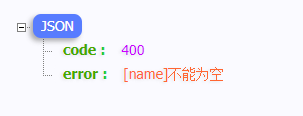您好,登錄后才能下訂單哦!
您好,登錄后才能下訂單哦!
怎么在Spring Boot項目中利用JSR-380進行校驗?相信很多沒有經驗的人對此束手無策,為此本文總結了問題出現的原因和解決方法,通過這篇文章希望你能解決這個問題。
JSR-380 是 J2EE 的一個規范,用于校驗實體屬性,它是 JSR-303 的升級版,在 Spring Boot 中可以基于它優雅實現參數校驗。
<!--more-->
在沒有使用 JSR-380 之前,我們一般都會將參數校驗硬編碼在 controller 類中,示例:
public Result add(@RequestBody User user){
if(StringUtils.isBlank(user.getName())){
return Result.error("用戶名不能為空");
}
// ...
}而使用 JSR-380 只需要通過添加對應的注解即可實現校驗,示例:
@Data
public class User{
@NotBlank
private String name;
private Integer age;
}public Result register(@Validated @RequestBody User user){
// ...
}這樣看起來代碼是不是清爽了很多,只需要在需要校驗的字段上加上對應的校驗注解,然后對需要校驗的地方加上 @Validated 注解,然后框架就會幫我們完成校驗。
框架校驗失敗之后會拋出異常,需要捕獲這個異常然后來自定義校驗不通過的錯誤響應,這里直接貼代碼,兼容 @RequestBody 、 @ModelAttribute 、 @RequestParam 三種入參的校驗:
@ControllerAdvice
public class GlobalExceptionHandler {
@ExceptionHandler(value = {MethodArgumentNotValidException.class, BindException.class})
public ResponseEntity<Result> methodArgumentNotValidHandler(HttpServletRequest request, Exception e) {
BindingResult bindingResult;
if (e instanceof MethodArgumentNotValidException) {
//@RequestBody參數校驗
bindingResult = ((MethodArgumentNotValidException) e).getBindingResult();
} else {
//@ModelAttribute參數校驗
bindingResult = ((BindException) e).getBindingResult();
}
FieldError fieldError = bindingResult.getFieldError();
return ResponseEntity.ok(Result.fail(Result.CODE_PARAMS_INVALID, "[" + fieldError.getField() + "]" + fieldError.getDefaultMessage()));
}
//@RequestParam參數校驗
@ExceptionHandler(value = {ConstraintViolationException.class, MissingServletRequestParameterException.class})
public ResponseEntity<Result> constraintViolationHandler(Exception e) {
String field;
String msg;
if (e instanceof ConstraintViolationException) {
ConstraintViolation<?> constraintViolation = ((ConstraintViolationException) e).getConstraintViolations().stream().findFirst().get();
List<Path.Node> pathList = StreamSupport.stream(constraintViolation.getPropertyPath().spliterator(), false)
.collect(Collectors.toList());
field = pathList.get(pathList.size() - 1).getName();
msg = constraintViolation.getMessage();
} else {
// 這個不是JSR標準返回的異常,要自定義提示文本
field = ((MissingServletRequestParameterException) e).getParameterName();
msg = "不能為空";
}
return ResponseEntity.ok(Result.fail(Result.CODE_PARAMS_INVALID, "[" + field + "]" + msg));
}
}然后再訪問一下接口,可以看到錯誤提示已經按自定義的規范顯示了:

可以看到都不需要寫任何提示文本就可以完成校驗和提示,上圖的 不能為空 是框架內置的 I18N 國際化支持,每個注解都內置相應的提示模板。
常用校驗注解
| 注解 | 描述 |
|---|---|
| @NotNull | 驗證值不為 null |
| @AssertTrue | 驗證值為 true |
| @Size | 驗證值的長度介于 min 和 max 之間,可應用于 String、Collection、Map 和數組類型 |
| @Min | 驗證值不小于該值 |
| @Max | 驗證值不大于該值 |
| 驗證字符串是有效的電子郵件地址 | |
| @NotEmpty | 驗證值不為 null 或空,可應用于 String、Collection、Map 和數組類型 |
| @NotBlank | 驗證字符串不為 null 并且不是空白字符 |
| @Positive | 驗證數字為正數 |
| @PositiveOrZero | 驗證數字為正數(包括 0) |
| @Negative | 驗證數字為負數 |
| @NegativeOrZero | 驗證數字為負數(包括 0) |
| @Past | 驗證日期值是過去 |
| @PastOrPresent | 驗證日期值是過去(包括現在) |
| @Future | 驗證日期值是未來 |
| @FutureOrPresent | 驗證日期值是未來(包括現在) |
看完上述內容,你們掌握怎么在Spring Boot項目中利用JSR-380進行校驗的方法了嗎?如果還想學到更多技能或想了解更多相關內容,歡迎關注億速云行業資訊頻道,感謝各位的閱讀!
免責聲明:本站發布的內容(圖片、視頻和文字)以原創、轉載和分享為主,文章觀點不代表本網站立場,如果涉及侵權請聯系站長郵箱:is@yisu.com進行舉報,并提供相關證據,一經查實,將立刻刪除涉嫌侵權內容。